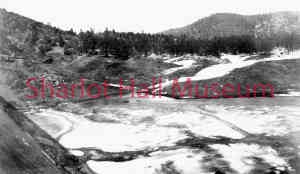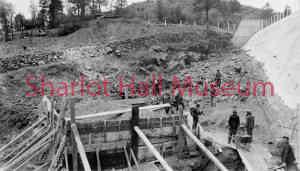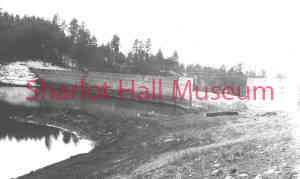By Drew Desmond

It was the biggest disaster to strike the city since the Great Fire of 1900, and it got progressively worse. By the time the summer of 1919 came along, water pressure had consistently fallen so low that everyone was required to boil it. Unfortunately, the Weekly Journal-Miner noted, that did nothing to relieve its foul smell.
Prescott was thrilled to learn that Ft. Whipple would be brought back to life as a hospital for US veterans suffering from tuberculosis. It would be an economic boom for the city. However, the new hospital had first rights to the water being pumped up from Del Rio Springs, which was also the largest source of freshwater for the city. Even before it was in full operation, the hospital was already consuming the majority of that water.
The crisis was even more acute for farmers around Chino Valley and Jerome Junction. Prescott had been allowing them to use city water for several years, but in May of 1918, the city needed to turn off the tap. Prescott also prohibited the railroad from using water from Miller Creek. Despite these efforts, the city was still consuming more water than it was capturing. In December of 1918, over 17 million gallons were consumed. The previous December, it was only 10 million.

Demand on the city’s water infrastructure was at its maximum when another catastrophe struck on October 1, 1918. Fire disabled the water plant at Del Rio Springs, causing an estimated $75,000 in damages (or about $1.1 million in today’s money). Fortunately, some repairs were able to be made and some water was delivered to the VA hospital complex, but they were now absorbing every drop of it.
Plans to enlarge the Del Rio plant were permanently scrapped when a water engineer employed by the city found that the source of Del Rio Springs was the same Granite Creek water that ran through the city! Instead of capturing the water at the source in the nearby mountains that fed Granite Creek, Prescott was waiting for it to flow 20 miles away while descending 1100 feet before pumping it back to the city. This was costing water customers a relatively whopping 60 cents to produce 1000 gallons of water. Today, that would put the average monthly water bill at around $270.
 It was found that if the water was captured in the mountains above the city and gravity employed to move it, the cost would plummet to 2 cents, or a water bill today of only $9. Two possible dam sites were studied as early as the late 19th century: Potts (now Butte) Creek and Aspen Creek, but neither of these was chosen. Eventually Bannon Creek was selected, but it would take four years to build the dam before water could be harvested from it. The new reservoir was named "Lake Goldwater" (Lower Goldwater Lake to us today). It could hold 100 million gallons of fresh water. It was estimated that the city of 8000 would now have enough water to serve a population of 50,000 - an incomprehensible number a hundred years ago.
It was found that if the water was captured in the mountains above the city and gravity employed to move it, the cost would plummet to 2 cents, or a water bill today of only $9. Two possible dam sites were studied as early as the late 19th century: Potts (now Butte) Creek and Aspen Creek, but neither of these was chosen. Eventually Bannon Creek was selected, but it would take four years to build the dam before water could be harvested from it. The new reservoir was named "Lake Goldwater" (Lower Goldwater Lake to us today). It could hold 100 million gallons of fresh water. It was estimated that the city of 8000 would now have enough water to serve a population of 50,000 - an incomprehensible number a hundred years ago.
Before the project was completed, however, during those long four years, it would take strict conservation by every citizen and the grace of enough wet weather to see the city through its water crisis. A decade later, Prescott’s capacity to store fresh water was greatly enhanced by the construction of Upper Goldwater Lake during the Great Depression.
“Days Past” is a collaborative project of the Sharlot Hall Museum and the Prescott Corral of Westerners International (www.prescottcorral.org). This and other Days Past articles are also available at archives.sharlothallmuseum.org/articles/days-past-articles/1 The public is encouraged to submit proposed articles and inquiries to dayspast@sharlothallmuseum.org Please contact SHM Research Center reference desk at 928-277-2003, or via email at archivesrequest@sharlothallmuseum.org for information or assistance with photo requests.


